Abstract
The influence of Staphylococcus aureus on peripheral blood lymphocytes (PBL) of patients with atopic dermatitis (AD) was analysed. The parameters studied were spontaneous and interleukin-inducible immunoglobulin (IgA, IgE, IgG) synthesis, as well as CD23 expression. Various heat-killed, clinical isolates of S. aureus were analysed. PBL from non-atopic donors served as controls. The time-course of co-cultured PBL with S. aureus showed a dose-dependent increase in immunoglobulin (Ig) synthesis from PBL of normal donors, whereas the Ig synthesis of atopic cells was significantly depressed. Additional stimulation with interleukin-4 (IL-4) also led to a pronounced suppression of the IgE and IgA synthesis in normal donor cells, while the effect of S. aureus on PBL of atopic donors was not markedly affected by IL-4. Transwell cultures of bacteria separated from PBL by a semi-permeable membrane induced stimulation of IgA and IgE synthesis in patients with AD. The Ig synthesis in the control group was not altered. Co-stimulation of S. aureus and IL-4 in this system led to a suppression of IgA with cells of both atopic and normal donors. IgE synthesis from atopic PBL was significantly stimulated. The CD23 expression of atopic PBL was increased by S. aureus and IL-4. Our data indicate that S. aureus may modulate the cytokine-dependent humoral immunity in patients with AD and that chronic colonization of the skin may be responsible for allergic skin reactions in AD.
Full text
PDF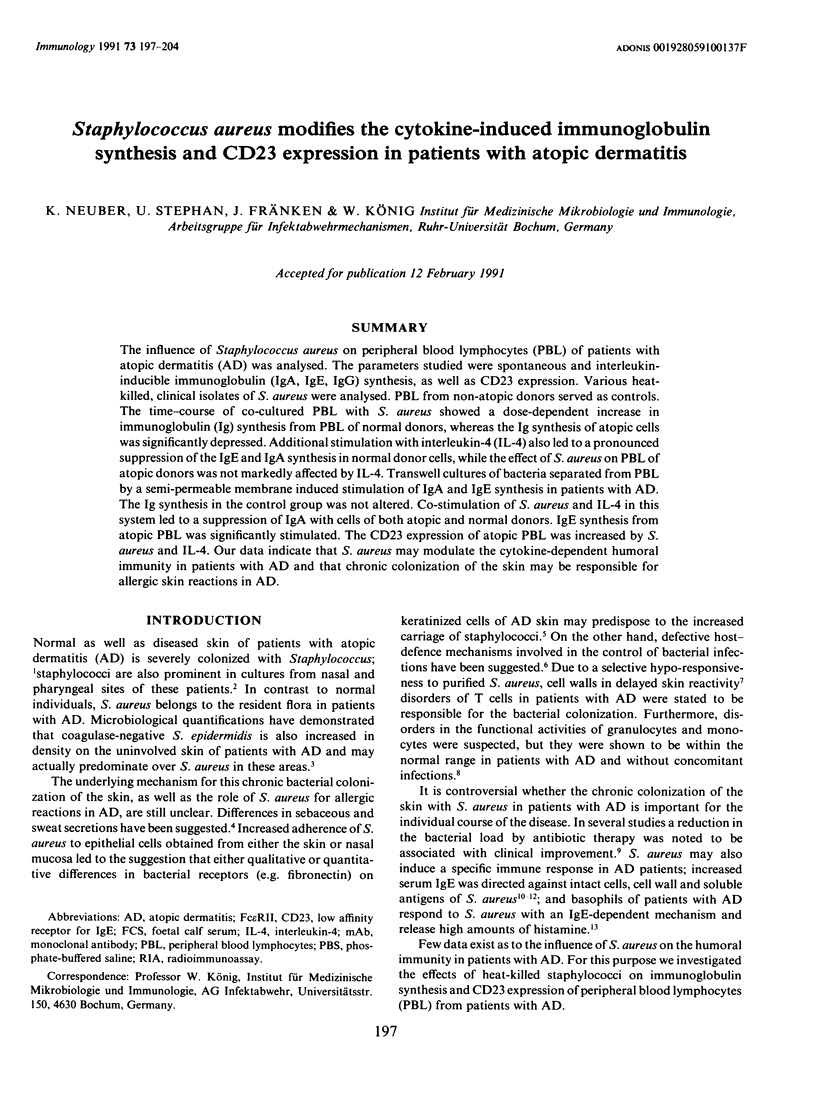
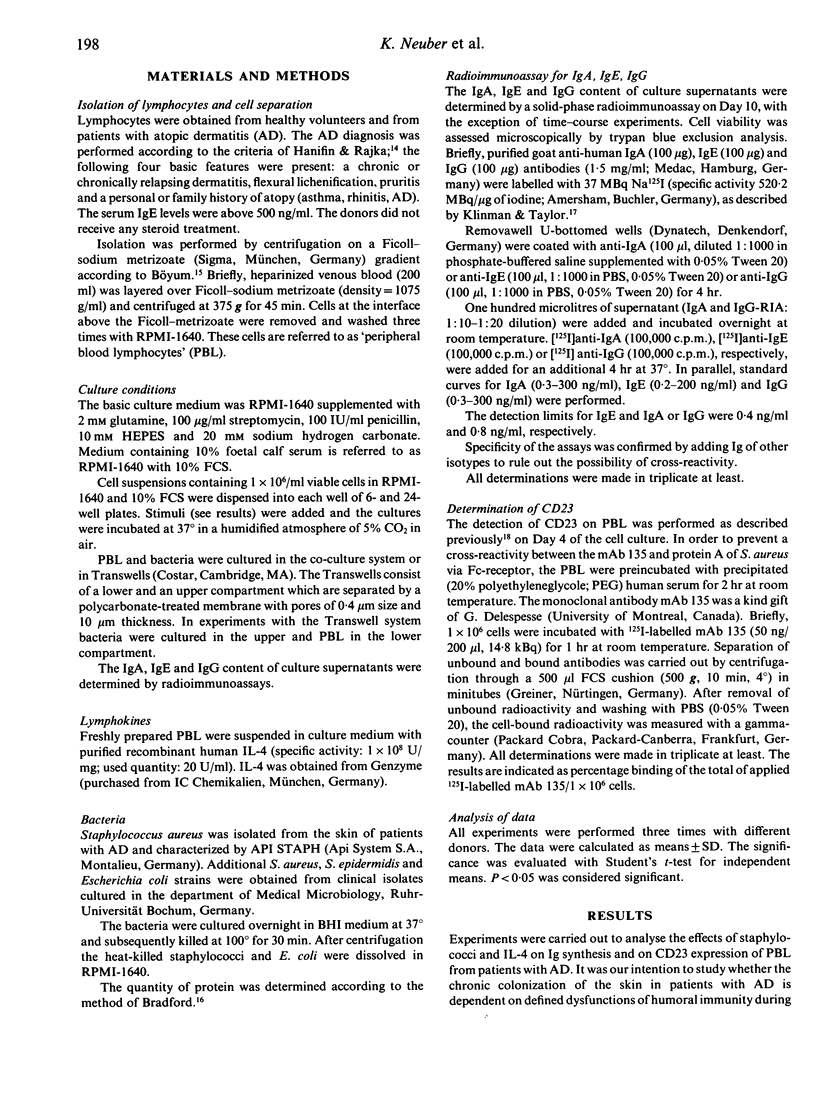
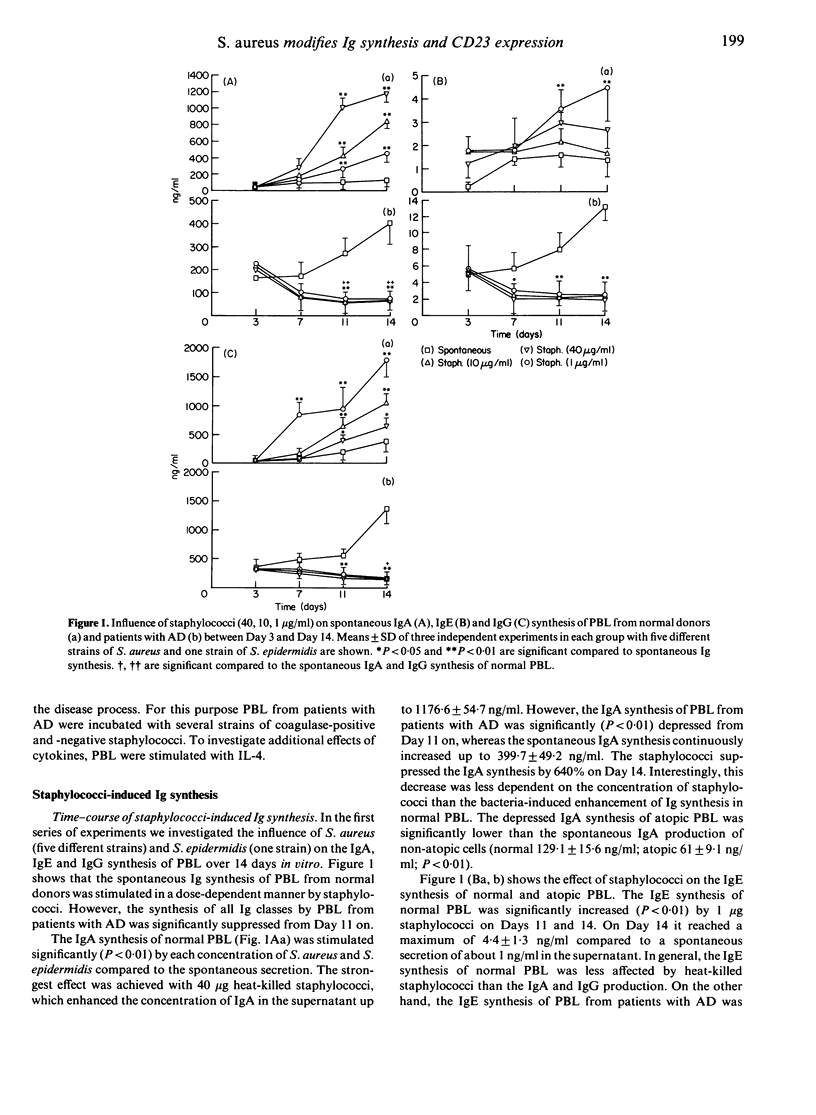
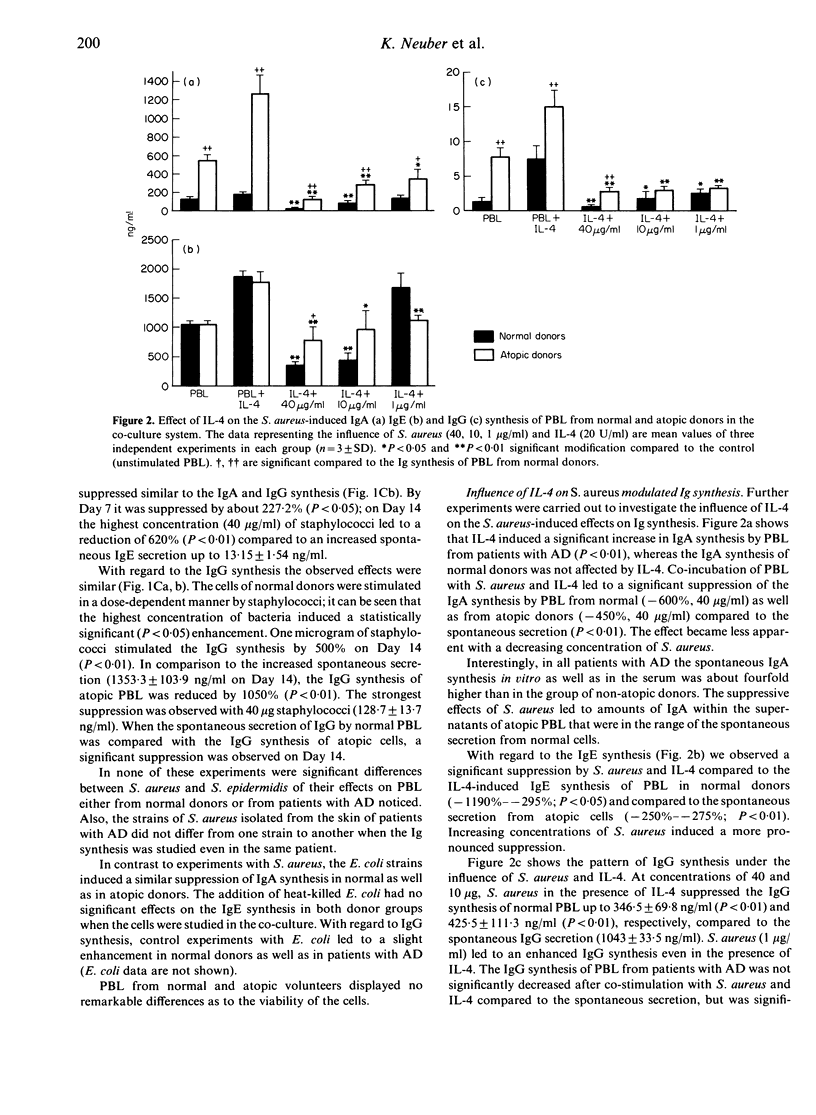
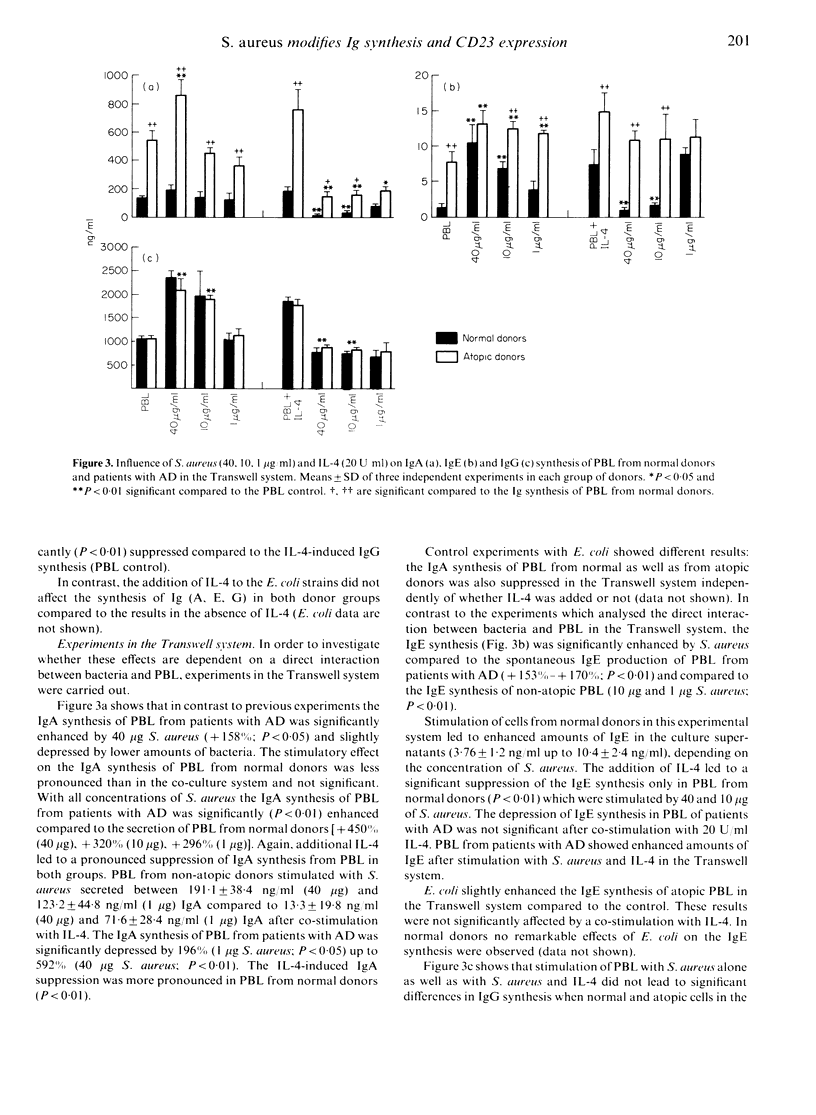
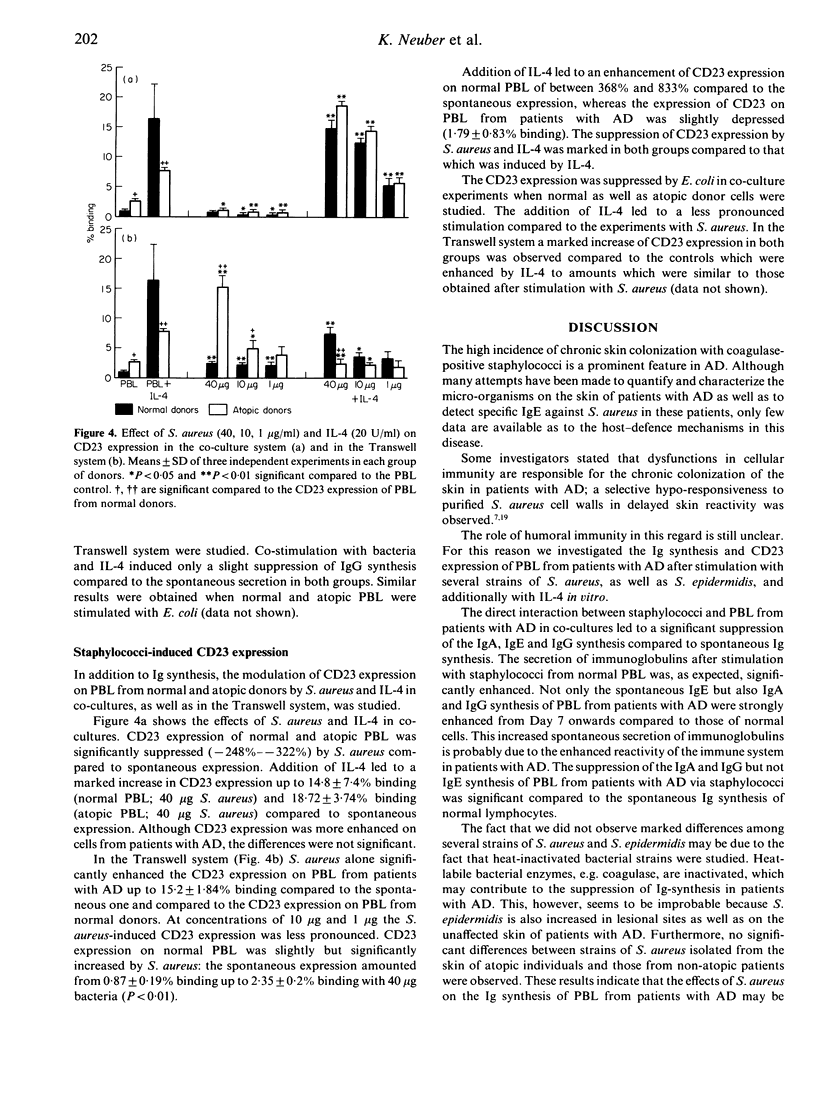
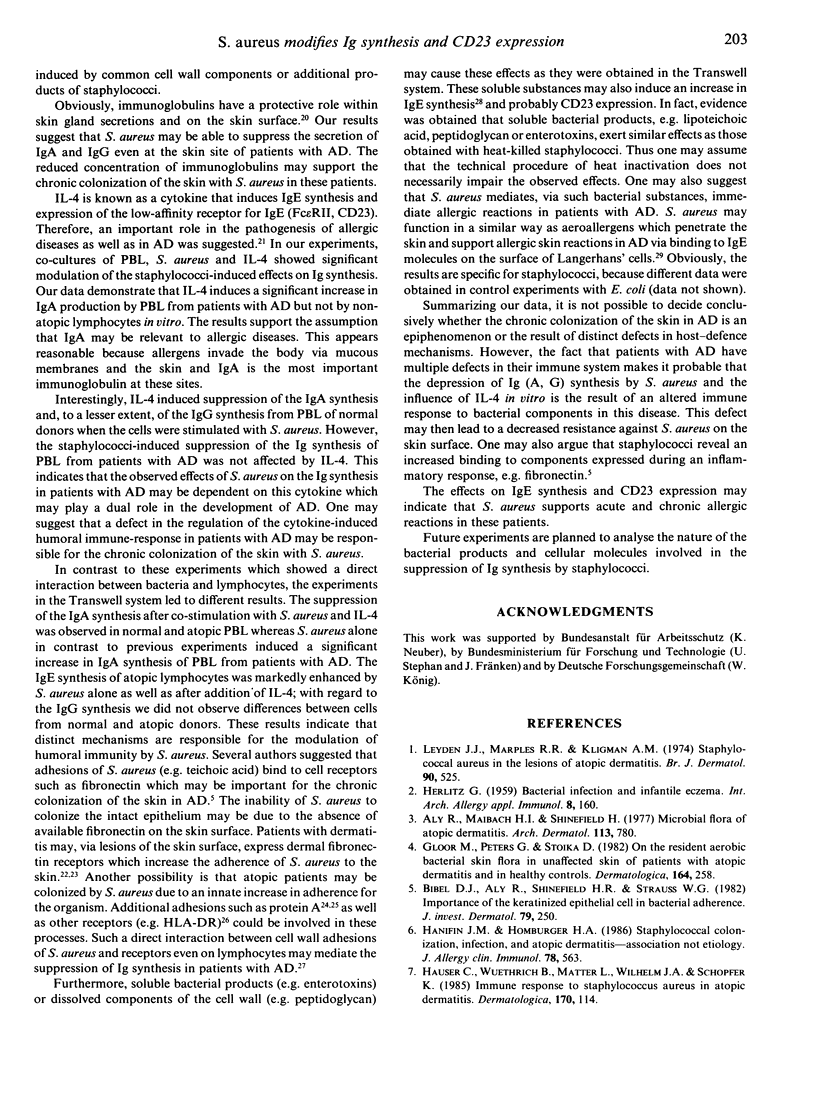
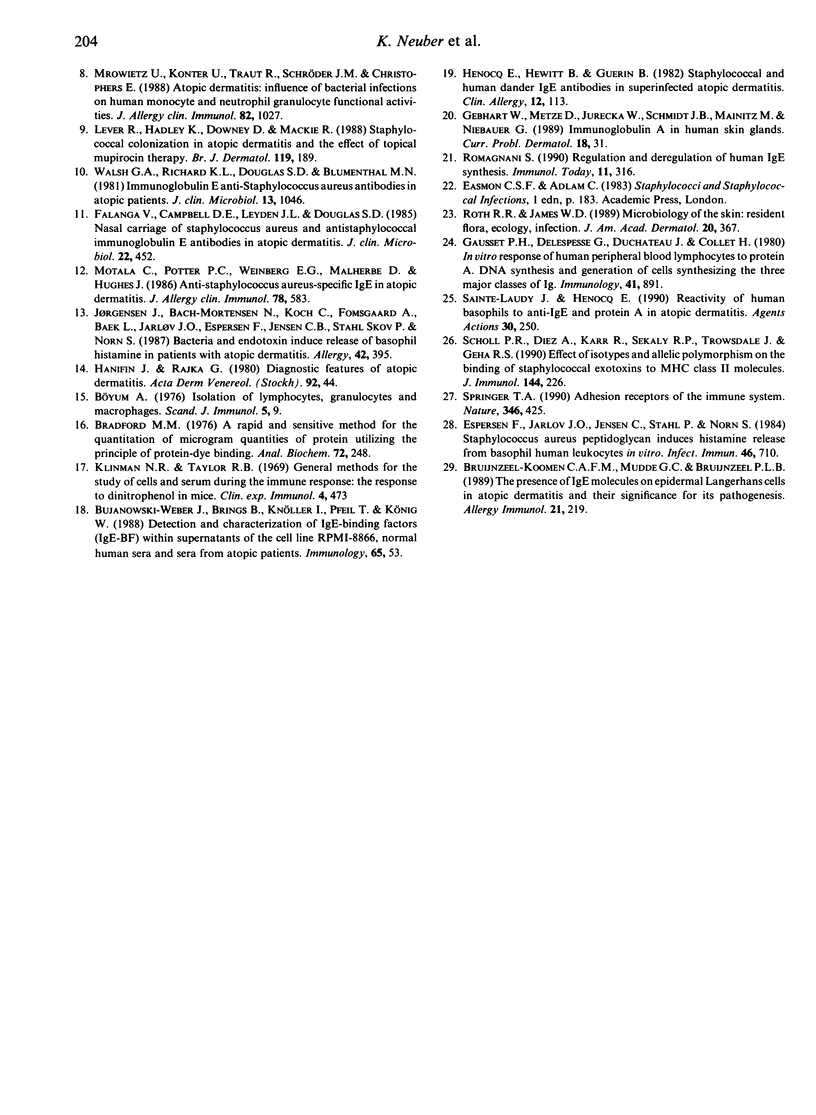
Selected References
These references are in PubMed. This may not be the complete list of references from this article.
- Aly R., Maibach H. I., Shinefield H. R. Microbial flora of atopic dermatitis. Arch Dermatol. 1977 Jun;113(6):780–782. [PubMed] [Google Scholar]
- Bibel D. J., Aly R., Shinefield H. R., Maibach H. I., Strauss W. G. Importance of the keratinized epithelial cell in bacterial adherence. J Invest Dermatol. 1982 Oct;79(4):250–253. doi: 10.1111/1523-1747.ep12500072. [DOI] [PubMed] [Google Scholar]
- Bradford M. M. A rapid and sensitive method for the quantitation of microgram quantities of protein utilizing the principle of protein-dye binding. Anal Biochem. 1976 May 7;72:248–254. doi: 10.1006/abio.1976.9999. [DOI] [PubMed] [Google Scholar]
- Bruijnzeel-Koomen C. A., Mudde G. C., Bruijnzeel P. L. The presence of IgE molecules on epidermal Langerhans cells in atopic dermatitis and their significance for its pathogenesis. Allerg Immunol (Paris) 1989 Jun;21(6):219–223. [PubMed] [Google Scholar]
- Bujanowski-Weber J., Knöller I., Brings B., Pfeil T., König W. Detection and characterization of IgE-binding factors (IgE-BF) within supernatants of the cell line RPMI-8866, normal human sera and sera from atopic patients. Immunology. 1988 Sep;65(1):53–58. [PMC free article] [PubMed] [Google Scholar]
- Bøyum A. Isolation of lymphocytes, granulocytes and macrophages. Scand J Immunol. 1976 Jun;Suppl 5:9–15. [PubMed] [Google Scholar]
- Espersen F., Jarløv J. O., Jensen C., Skov P. S., Norn S. Staphylococcus aureus peptidoglycan induces histamine release from basophil human leukocytes in vitro. Infect Immun. 1984 Dec;46(3):710–714. doi: 10.1128/iai.46.3.710-714.1984. [DOI] [PMC free article] [PubMed] [Google Scholar]
- Falanga V., Campbell D. E., Leyden J. J., Douglas S. D. Nasal carriage of Staphylococcus aureus and antistaphylococcal immunoglobulin E antibodies in atopic dermatitis. J Clin Microbiol. 1985 Sep;22(3):452–454. doi: 10.1128/jcm.22.3.452-454.1985. [DOI] [PMC free article] [PubMed] [Google Scholar]
- Gausset P., Delespesse G., Duchateau J., Collet H. In vitro response of human peripheral blood lymphocytes of protein A. DNA synthesis and generation of cells synthesizing the three major classes of Ig. Immunology. 1980 Dec;41(4):891–897. [PMC free article] [PubMed] [Google Scholar]
- Gebhart W., Metze D., Jurecka W., Schmidt J. B., Mainitz M., Niebauer G. Immunoglobulin A in human skin glands. Curr Probl Dermatol. 1989;18:31–36. doi: 10.1159/000416835. [DOI] [PubMed] [Google Scholar]
- Gloor M., Peters G., Stoika D. On the resident aerobic bacterial skin flora in unaffected skin of patients with atopic dermatitis and in healthy controls. Dermatologica. 1982 Apr;164(4):258–265. doi: 10.1159/000250099. [DOI] [PubMed] [Google Scholar]
- HERLITZ G. Bacterial infection and infantile eczema. Int Arch Allergy Appl Immunol. 1956;8(3):160–164. doi: 10.1159/000228278. [DOI] [PubMed] [Google Scholar]
- Hanifin J. M., Homburger H. A. Staphylococcal colonization, infection, and atopic dermatitis--association not etiology. J Allergy Clin Immunol. 1986 Oct;78(4 Pt 1):563–566. doi: 10.1016/0091-6749(86)90071-0. [DOI] [PubMed] [Google Scholar]
- Hauser C., Wuethrich B., Matter L., Wilhelm J. A., Schopfer K. Immune response to Staphylococcus aureus in atopic dermatitis. Dermatologica. 1985;170(3):114–120. doi: 10.1159/000249514. [DOI] [PubMed] [Google Scholar]
- Hénocq E., Hewitt B., Guerin B. Staphylococcal and human dander IgE antibodies in superinfected atopic dermatitis. Clin Allergy. 1982 Mar;12(2):113–120. doi: 10.1111/j.1365-2222.1982.tb01629.x. [DOI] [PubMed] [Google Scholar]
- Jørgensen J., Bach-Mortensen N., Koch C., Fomsgaard A., Baek L., Jarløv J. O., Espersen F., Jensen C. B., Skov P. S., Norn S. Bacteria and endotoxin induce release of basophil histamine in patients with atopic dermatitis. In vitro experiments with S. aureus, teichoic acid, E. coli and E. coli LPS. Allergy. 1987 Jul;42(5):395–397. doi: 10.1111/j.1398-9995.1987.tb02227.x. [DOI] [PubMed] [Google Scholar]
- Klinman N. R., Taylor R. B. General methods for the study of cells and serum during the immune response: the response to dinitrophenyl in mice. Clin Exp Immunol. 1969 Apr;4(4):473–487. [PMC free article] [PubMed] [Google Scholar]
- Lever R., Hadley K., Downey D., Mackie R. Staphylococcal colonization in atopic dermatitis and the effect of topical mupirocin therapy. Br J Dermatol. 1988 Aug;119(2):189–198. doi: 10.1111/j.1365-2133.1988.tb03201.x. [DOI] [PubMed] [Google Scholar]
- Leyden J. J., Marples R. R., Kligman A. M. Staphylococcus aureus in the lesions of atopic dermatitis. Br J Dermatol. 1974 May;90(5):525–530. doi: 10.1111/j.1365-2133.1974.tb06447.x. [DOI] [PubMed] [Google Scholar]
- Mrowietz U., Konter U., Traut R., Schröder J. M., Christophers E. Atopic dermatitis: influence of bacterial infections on human monocyte and neutrophil granulocyte functional activities. J Allergy Clin Immunol. 1988 Dec;82(6):1027–1036. doi: 10.1016/0091-6749(88)90140-6. [DOI] [PubMed] [Google Scholar]
- Romagnani S. Regulation and deregulation of human IgE synthesis. Immunol Today. 1990 Sep;11(9):316–321. doi: 10.1016/s0167-5699(10)80004-0. [DOI] [PubMed] [Google Scholar]
- Roth R. R., James W. D. Microbiology of the skin: resident flora, ecology, infection. J Am Acad Dermatol. 1989 Mar;20(3):367–390. doi: 10.1016/s0190-9622(89)70048-7. [DOI] [PubMed] [Google Scholar]
- Sainte-Laudy J., Henocq E. Reactivity of human basophils to anti-IgE and protein A in atopic dermatitis. Agents Actions. 1990 Apr;30(1-2):250–253. doi: 10.1007/BF01969052. [DOI] [PubMed] [Google Scholar]
- Scholl P. R., Diez A., Karr R., Sekaly R. P., Trowsdale J., Geha R. S. Effect of isotypes and allelic polymorphism on the binding of staphylococcal exotoxins to MHC class II molecules. J Immunol. 1990 Jan 1;144(1):226–230. [PubMed] [Google Scholar]
- Springer T. A. Adhesion receptors of the immune system. Nature. 1990 Aug 2;346(6283):425–434. doi: 10.1038/346425a0. [DOI] [PubMed] [Google Scholar]


